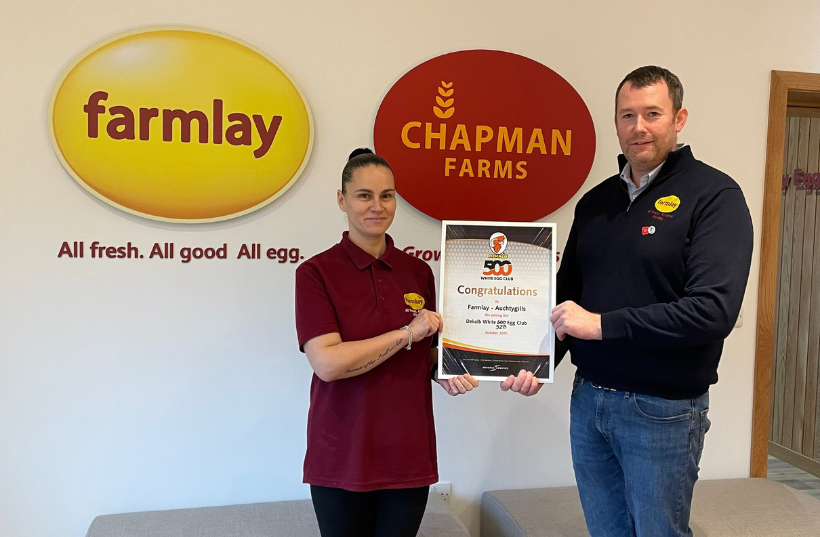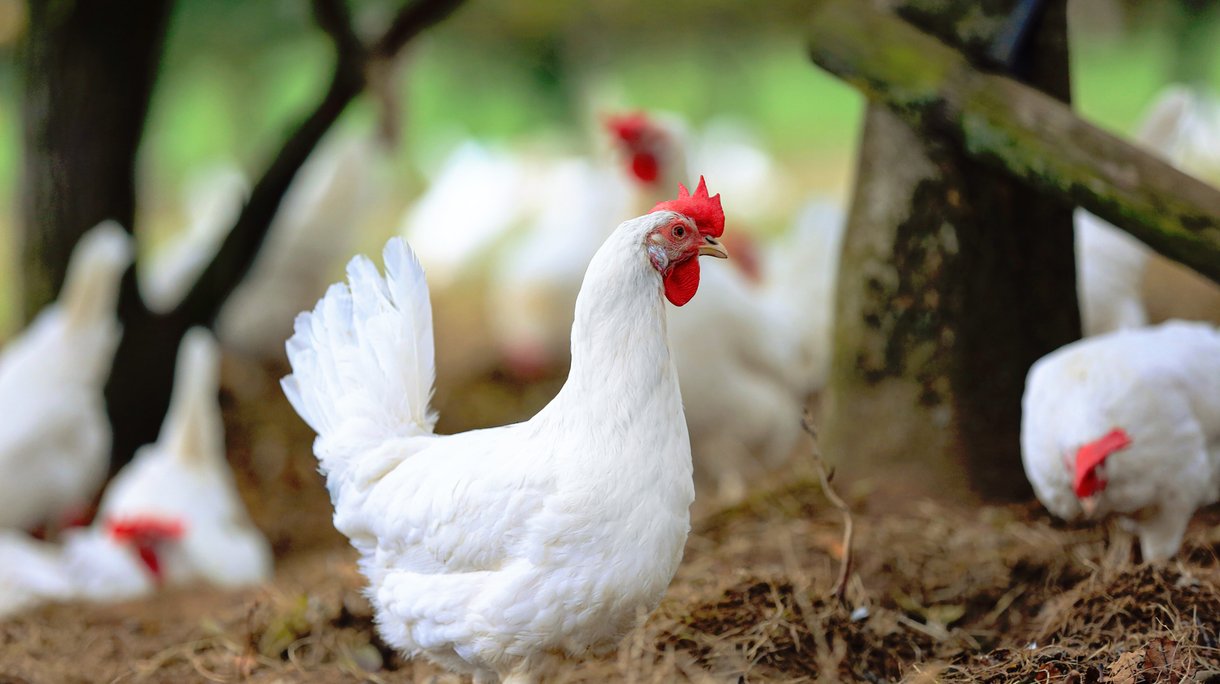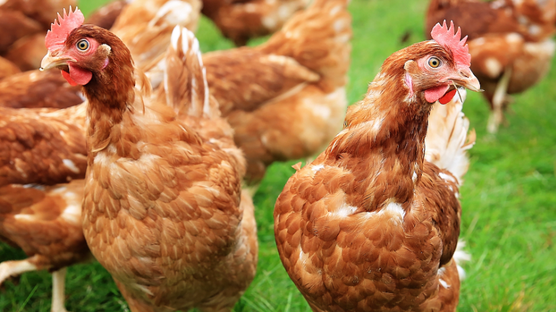
Published on Nov. 10, 2025
Farmlay - From Modest Beginnings to Major Retail Supplier
With nearly 80 years of production behind it and more than 7 million eggs packed each week, Iain Chapman of Scottish egg packer and producer, Farmlay, sees white flocks as a growing part of the retail landscape - with the potential to become the new backbone of UK egg supply. In this post, Ian and his Poultry Farms Manager, Christine James, discuss why they think white birds will revolutionise the egg sector.
The Farmlay story began in 1946, when Iain Chapman’s grandparents moved to Strichen in Aberdeenshire. “The farm was rudimentary when they moved in, with no running water,” he recalls, “the business always included laying hens, probably starting with 50 birds and then into the hundreds, with the first purpose-built shed being erected in 1963.”
The next generation continued to develop the business, with Iain’s parents, Robert and Ethel, gradually building the business into a significant regional supplier. The modern Farmlay was shaped in the mid-1990s, when Robert’s brother left the business to focus on dairy and arable farming, leaving Robert and Ethel to concentrate solely on eggs.

A breakthrough
A breakthrough came when their approaches to supermarkets finally came good “It wasn’t easy,” recalls Iain Chapman, now Managing Director. “Mum and dad kept persevering, and in the end Morrisons came to us. They needed eggs within three months, so we built and stocked four mobile sheds, ready to supply.”
Although that supply relationship ended after a decade, it gave Farmlay the scale and confidence to pursue long-term partnerships. Since 2010, Aldi has been a consistent customer, and alongside Lidl, has become a particularly important driver of growth. The company now operates a second depot to serve Lidl’s requirements, with demand for white eggs growing fastest through this channel.
Today, Farmlay packs around 7 million eggs per week, working with 26 contract producers across Scotland. “We’re still a family business dealing with other family businesses,” says Iain. “Our producers can pick up the phone and speak directly to us. We don’t dictate their feed suppliers or breeds. That flexibility is part of why we’ve only ever lost one producer in all the years we’ve been running.”
White birds: a game changer in flock management
While Farmlay’s growth story is impressive, it is the company’s recent experience with white birds – specifically Dekalb White flocks – that could reshape the UK industry. Poultry Farms Manger Christine James’ farm at Auchtygills was the first farm to house a flock of Dekalb White birds, hatched by Joice and Hill.
“We chose DKW on the back of the messaging around their potential for 500 eggs, the feed conversion claims, and technical visits to the Netherlands, with Joice and Hill,” she explains. “We rear all our own chicks, which gives us better quality control and allows me plenty chance to observe the birds from day one. I love the Dekalb chicks in rear, they are such playful birds.”
She admits to being apprehensive at first. “Their reputation for ease of management, fewer floor eggs and high production preceded them,” she says, “and I was nervous in case they didn’t perform for me! But from two weeks into production, we knew they were completely different. For example, we had experienced problems with previous flocks on floor eggs, but at 22 weeks old we recorded 0.5% floor eggs and at 32 weeks old 0.08%, in fact over the first three months the Dekalbs never exceeded 100 floor eggs out of 45,000 birds.
“With brown birds we had a full-time person picking up floor eggs, anything up to 3,000 a day – which is an awful and time-consuming job, by contrast white birds make management so much easier – one person can manage 45,000 birds.
“At 99 weeks old our first flock of Dekalb White birds recorded an incredible 509.2 eggs per hen housed. Average mortality was just 3.26%, significantly lower than industry norms and offsetting any concerns about vaccine efficacy over longer cycles. We originally penciled them in for 85 weeks, but soon upgraded our expectations, and we took them to 103 weeks with final figures of 528 eggs per hen housed.
“Unlike brown birds, which crowd around people, whites move calmly out of the way. It makes management simpler. They’re a joy to work with – playful, easier to rear, and much faster to train onto the system than brown birds. It only takes 2 or 3 days to train them up on the system, and they don’t drift to the floor as they age, like browns,” Christine adds, “you just need to learn what they like, for example we noticed they like to be a bit warmer, but it’s nothing we can’t deal with - and it’s worth it.”
“Egg size is perfect and very uniform, we had to drop ration to keep the egg size where we want it and the average is now 64 grams, exactly what we aim for. Feed consumption is less than brown, and consistent,” Iain adds. “One problem we do have with white birds is keeping them on the range, they are adventurous rangers, unless it’s snowing! We have had to raise the height of fencing, but if that’s the only negative we can live with it. Overall, all Dekalb flocks are doing well, and they are doing what we were promised, and we have ordered an additional four flocks in addition to replacements for the current flocks.”

People just want good eggs
Looking to the future, Iain can see big changes coming. “The war in Ukraine provided a golden opportunity for white eggs. With input costs soaring and margins squeezed, producers began to leave the sector, whilst retailers, faced with shortages, were more open to change,” he explains. “The trend is only just beginning. Within a few years, up to half of all shell eggs at retail could be white. They make excellent poached eggs, they’re efficient to produce, and they’re already winning acceptance. This isn’t a short-term fix – it’s the future of the category.
“I am not convinced retailers are committed to barn as a way to provide a value line. There is not much difference in the cost of production compared to free range, so I think retailers will find other ways to offer value – perhaps offering smaller eggs or pack sizes of 18 or 30. Hopefully eggs will just be eggs at the free-range level with consumers happy to accept whatever colour egg is in the pack.
“We are not too concerned about fears of price pressure from retailers. Lidl originally discussed whites as a budget range,” explains Iain. “But in practice, they accepted eggs of any colour at the same price.”
Christine agrees: “White birds aren’t just a trend – they’re the new standard. We can manage them more easily, they produce efficiently, and consumers are embracing white eggs without hesitation. Walk into any supermarket today and you’ll see whites on the shelf. That would have been unthinkable just a few years ago. Consumers have shown less resistance than predicted. In fact. I think the industry overplayed the consumer’s attachment to brown eggs – people just want good eggs.”
Pictured: Christine James and Iain Chapman with their Dekalb White 500 Egg Club certificate



